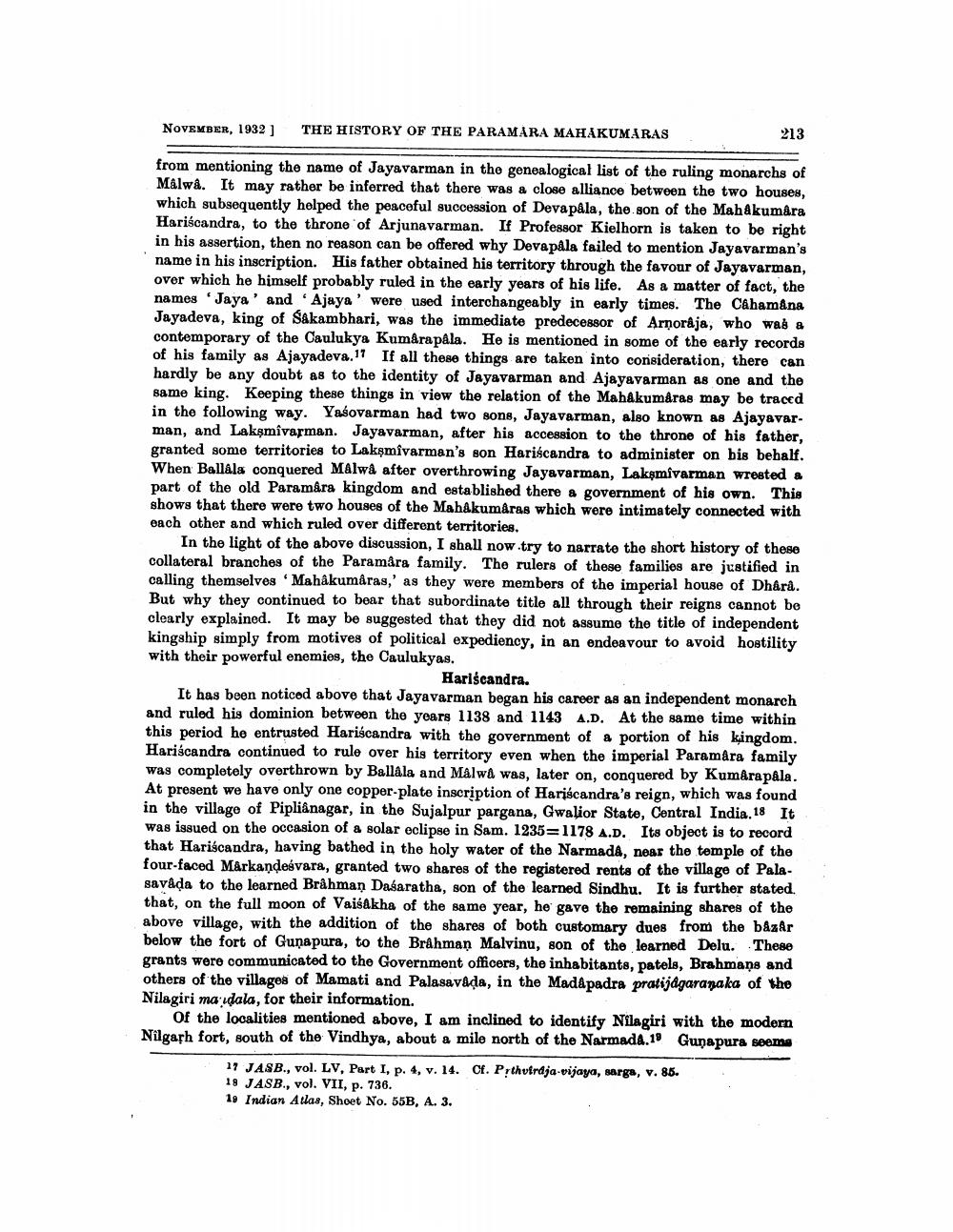________________
NOVEMBER, 1932)
THE HISTORY OF THE PARAMARA MAHAKUMARAS
213
from mentioning the name of Jayavarman in the genealogical list of the ruling monarchs of Mâlwa. It may rather be inferred that there was a close alliance between the two houses, which subsequently helped the peaceful succession of Deva pala, the son of the Mahakumara Hariscandra, to the throne of Arjunavarman. If Professor Kielhorn is taken to be right in his assertion, then no reason can be offered why Devapala failed to mention Jayavarman's name in his inscription. His father obtained his territory through the favour of Jayavarman, over which he himself probably ruled in the early years of his life. As a matter of fact, the names 'Jaya' and 'Ajaya' were used interchangeably in early times. The Cahamana Jayadeva, king of Sakambhari, was the immediate predecessor of Arnorâja, who was & contemporary of the Caulukya Kumarapala. He is mentioned in some of the early records of his family as Ajayadeva 17 If all these things are taken into consideration, there can hardly be any doubt as to the identity of Jayavarman and Ajayavarman as one and the game king. Keeping these things in view the relation of the Mahakumaras may be traced in the following way. Yasovarman had two sons, Jayavarman, also known as Ajayavarman, and Lakşmivarman. Jayavarman, after his accession to the throne of his father, granted some territories to Lakşmivarman's son Hariscandra to administer on bis behalf. When Ballála conquered Malwa after overthrowing Jayavarman, Lakşmivarman wrested & part of the old Paramâra kingdom and established there a government of his own. This shows that there were two houses of the Mahakumâras which were intimately connected with each other and which ruled over different territories.
In the light of the above discussion, I shall now.try to narrate the short history of these collateral branches of the Paramara family. The rulers of these families are justified in calling themselves Mahâkumaras,' as they were members of the imperial house of Dhårå. But why they continued to bear that subordinate title all through their reigns cannot be clearly explained. It may be suggested that they did not assume the title of independent kingship simply from motives of political expediency, in an endeavour to avoid hostility with their powerful enemies, the Caulukyas.
Hariscandra. It has been noticed above that Jayavarman began his career as an independent monarch and ruled his dominion between the years 1138 and 1143 A.D. At the same time within this period he entrusted Hariscandra with the government of a portion of his kingdom. Hariscandra continued to rule over his territory even when the imperial Paramára family was completely overthrown by Ballâla and Malwa was, later on, conquered by Kumarapala. At present we have only one copper-plate inscription of Hariscandra's reign, which was found in the village of Pipliânagar, in the Sujalpur Pargana, Gwalior State, Central India. 18 It was issued on the occasion of a solar eclipse in Sam. 1235=1178 A.D. Its object is to record that Hariscandra, having bathed in the holy water of the Narmada, near the temple of the four-faced Markandesvara, granted two shares of the registered rents of the village of Pala. savada to the learned Brahman Dasaratha, son of the learned Sindhu. It is further stated. that, on the full moon of Vaisakha of the same year, he gave the remaining shares of the above village, with the addition of the shares of both customary dues from the bazar below the fort of Gunapura, to the Brahman Malvinu, son of the learned Delu. These grants were communicated to the Government officers, the inhabitants, patels, Brahmans and others of the villages of Mamati and Palasavada, in the Madâpadra pratijagaranaka of the Nilagiri ma dala, for their information.
of the localities mentioned above, I am inclined to identify Nilagiri with the modern Nilgaph fort, south of the Vindhya, about a mile north of the NarmadA.18 Gunapura seems
17 JASB., vol. LV, Part I, p. 4, v. 14. Cf. Pythvirdja-vijaya, sarga, v. 85. 19 JASB., vol. VII, p. 736. 19 Indian Atlas, Shoet No. 55B, A. 3.




